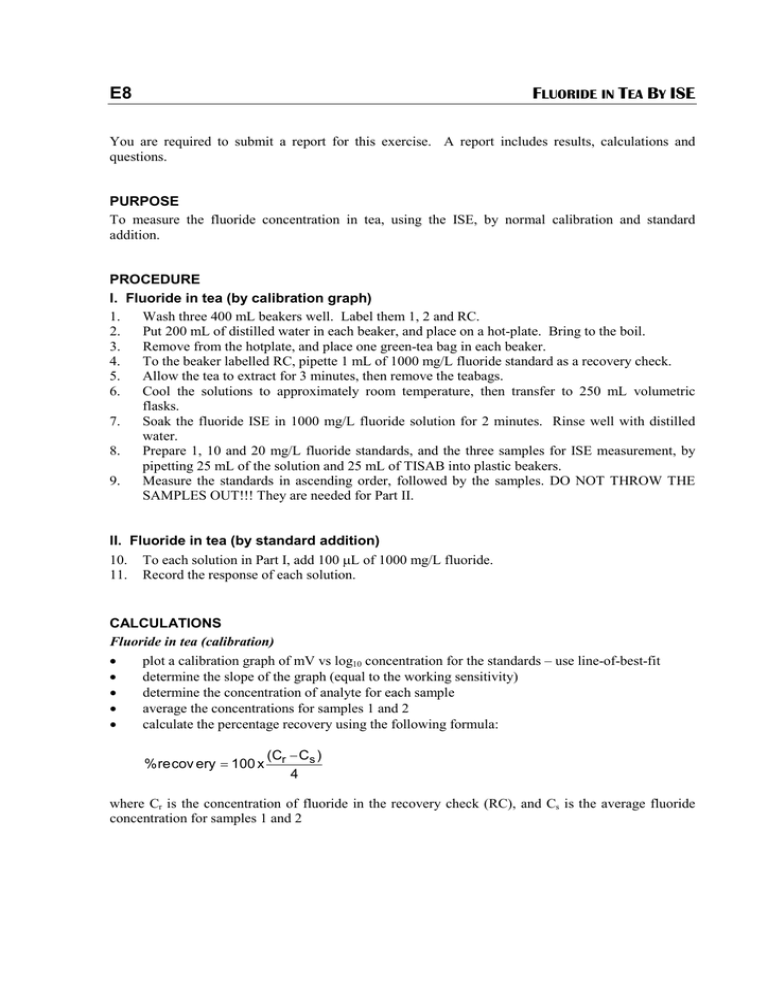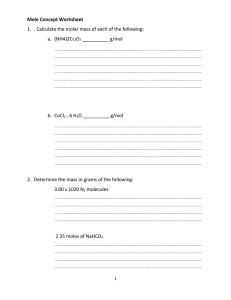E8 F T
advertisement

E8 FLUORIDE IN TEA BY ISE You are required to submit a report for this exercise. A report includes results, calculations and questions. PURPOSE To measure the fluoride concentration in tea, using the ISE, by normal calibration and standard addition. PROCEDURE I. Fluoride in tea (by calibration graph) 1. Wash three 400 mL beakers well. Label them 1, 2 and RC. 2. Put 200 mL of distilled water in each beaker, and place on a hot-plate. Bring to the boil. 3. Remove from the hotplate, and place one green-tea bag in each beaker. 4. To the beaker labelled RC, pipette 1 mL of 1000 mg/L fluoride standard as a recovery check. 5. Allow the tea to extract for 3 minutes, then remove the teabags. 6. Cool the solutions to approximately room temperature, then transfer to 250 mL volumetric flasks. 7. Soak the fluoride ISE in 1000 mg/L fluoride solution for 2 minutes. Rinse well with distilled water. 8. Prepare 1, 10 and 20 mg/L fluoride standards, and the three samples for ISE measurement, by pipetting 25 mL of the solution and 25 mL of TISAB into plastic beakers. 9. Measure the standards in ascending order, followed by the samples. DO NOT THROW THE SAMPLES OUT!!! They are needed for Part II. II. Fluoride in tea (by standard addition) 10. To each solution in Part I, add 100 µL of 1000 mg/L fluoride. 11. Record the response of each solution. CALCULATIONS Fluoride in tea (calibration) • plot a calibration graph of mV vs log10 concentration for the standards – use line-of-best-fit • determine the slope of the graph (equal to the working sensitivity) • determine the concentration of analyte for each sample • average the concentrations for samples 1 and 2 • calculate the percentage recovery using the following formula: % re cov ery = 100 x (Cr − Cs ) 4 where Cr is the concentration of fluoride in the recovery check (RC), and Cs is the average fluoride concentration for samples 1 and 2 Fluoride in tea (standard addition) Use the standard addition equation in your notes – Eqn 3.4. • • • • • calculate the concentration of extra fluoride added (using C1V1 = C2V2) using this and the value of the working sensitivity (S) calculated above, calculate the concentration of fluoride in each solution apply the dilution factor (x 2) to determine the concentration of fluoride in each sample average the concentrations for samples 1 and 2 calculate the percentage recovery using the same formula as above QUESTIONS 1. How does the working sensitivity for the electrode compare with the expected value? 2. What are the typical levels of fluoride in tea (see reference)? How do your results compare? Suggest reasons for differences. Reference “Fluoride content of Iranian tea” (available on prac exercise webpage) E8 - FLUORIDE IN TEA BY ISE RESULTS SHEET Tea bag ID Brand Barcode Expiry date ISE Measurements Solution mV mV after std addition 1 mg/L 10 mg/L 20 mg/L Sample 1 Sample 2 RC Tester’s signature ________________________________ Date _______________ Supervisor’s signature ______________________________ Date ______________




